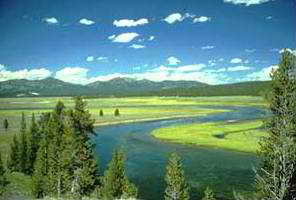Wyoming

Hayden Valley, Yellowstone National Park - photo by US National Park
Service
 Wyoming
WyomingOn
March 14, 2010 the Eastern Native Tree Society and Western Native Tree
Society switched from discussion lists on Google Groups to a new
discussion list in a Bulletin Board format at:
http://www.ents-bbs.org/index.php Posts made since the inception
of the BBS on March 14, 2010 will be sorted and archived on the BBS.
Click on the link to go to the equivalent section on the new BBS. This
website will continue to serve as a front end for the ENTS and WNTS
groups. It will continue to serve as a repository of older posts, and
will serve as the host site for special projects and features that are
not well suited for a BBS format. Please visit the BBS for the latest
information and trip reports.
Field Trips and Discussions
-
Cottonwoods, Cedars, Ralston, Wyoming..
-
Burn recovery in
Yellowstone July 1, 2009
 http://earthobservatory.nasa.gov/Features/WorldOfChange/yellowstone.php?src=eoa-features
http://earthobservatory.nasa.gov/Features/WorldOfChange/yellowstone.php?src=eoa-features
-
Chronicles
of western trip of Monica and Bob Leverett, July/Aug 2006
- Day 6 Black Hills,
SD, Devils Tower, WY, Bighorns, WY
- Day 7 Bighorn Mtns,
Tensleep Canyon, Popo Agie River, WY
- Po Po Agie River,
Wind Riverís Sinks Canyon and Red Canyon, WY
- Yellowstone National Park
 March 2008
March 2008
- Bear Lodge (Devils Tower)
 Feb 2008
Feb 2008
- Big Horn Mountains - My Ultimate Mountain Mecca
- Bob Leverett March 2008
- Medicine Wheel
National Historic Landmark July 2006.
 Yellowstone National Park http://www.nps.gov/yell/
Yellowstone is clothed in forests, covering roughly 80 percent of the
park. Miles and miles of lodgepole pine forest characterize the park,
especially within the confines of the Yellowstone caldera. Also present
in the park are extensive areas of forest dominated by subalpine fir and
Engelmann spruce, especially in areas underlain by andesites such as the
Absaroka Range. These species can also be common in the understory where
the canopy is entirely composed of lodgepole pine. Through time, in the
absence of fire, the subalpine fir and Engelmann spuce will replace the
lodgepole pine, leading to a canopy dominated by these species. At
higher elevations, such as the Absaroka Mountains and the Washburn
Range, whitebark pine becomes a significant component of the forest. In
the upper subalpine zone, whitebark pine, Engelmann spruce, and
subalpine fir often grow in small areas separated by subalpine meadows.
Yellowstone National Park http://www.nps.gov/yell/
Yellowstone is clothed in forests, covering roughly 80 percent of the
park. Miles and miles of lodgepole pine forest characterize the park,
especially within the confines of the Yellowstone caldera. Also present
in the park are extensive areas of forest dominated by subalpine fir and
Engelmann spruce, especially in areas underlain by andesites such as the
Absaroka Range. These species can also be common in the understory where
the canopy is entirely composed of lodgepole pine. Through time, in the
absence of fire, the subalpine fir and Engelmann spuce will replace the
lodgepole pine, leading to a canopy dominated by these species. At
higher elevations, such as the Absaroka Mountains and the Washburn
Range, whitebark pine becomes a significant component of the forest. In
the upper subalpine zone, whitebark pine, Engelmann spruce, and
subalpine fir often grow in small areas separated by subalpine meadows.
 Grand Tetons National Park
http://www.nps.gov/grte/ Located
in northwestern Wyoming, Grand Teton National Park protects stunning
mountain scenery and a diverse array of wildlife. The central feature of
the park is the Teton Range ó an active, fault-block, 40-mile-long
mountain front. The range includes eight peaks over 12,000 feet (3,658
m), including the Grand Teton at 13,770 feet (4,198 m). Seven morainal
lakes run along the base of the range, and more than 100 alpine lakes
can be found in the backcountry.
Grand Tetons National Park
http://www.nps.gov/grte/ Located
in northwestern Wyoming, Grand Teton National Park protects stunning
mountain scenery and a diverse array of wildlife. The central feature of
the park is the Teton Range ó an active, fault-block, 40-mile-long
mountain front. The range includes eight peaks over 12,000 feet (3,658
m), including the Grand Teton at 13,770 feet (4,198 m). Seven morainal
lakes run along the base of the range, and more than 100 alpine lakes
can be found in the backcountry.
 GORP - Wyoming
Wilderness Areas http://gorp.away.com/gorp/resource/us_wilderness_area/wy.htm
Absaroka-Beartooth, Bridger, Cloud Peak, Encampment River, Fitzpatrick, Gros Ventre, Huston Park, Jedediah Smith, North Absaroka, Platte River, Popo Agie, Savage Run, Teton Wilderness Area, Washakie, Winegar Hole. Wilderness at Risk - Wild BLM lands in Wyoming, including the Red Desert, Powder River Basin, and Bridger Country. GORP - Wyoming
Wilderness Areas http://gorp.away.com/gorp/resource/us_wilderness_area/wy.htm
Absaroka-Beartooth, Bridger, Cloud Peak, Encampment River, Fitzpatrick, Gros Ventre, Huston Park, Jedediah Smith, North Absaroka, Platte River, Popo Agie, Savage Run, Teton Wilderness Area, Washakie, Winegar Hole. Wilderness at Risk - Wild BLM lands in Wyoming, including the Red Desert, Powder River Basin, and Bridger Country.
|
